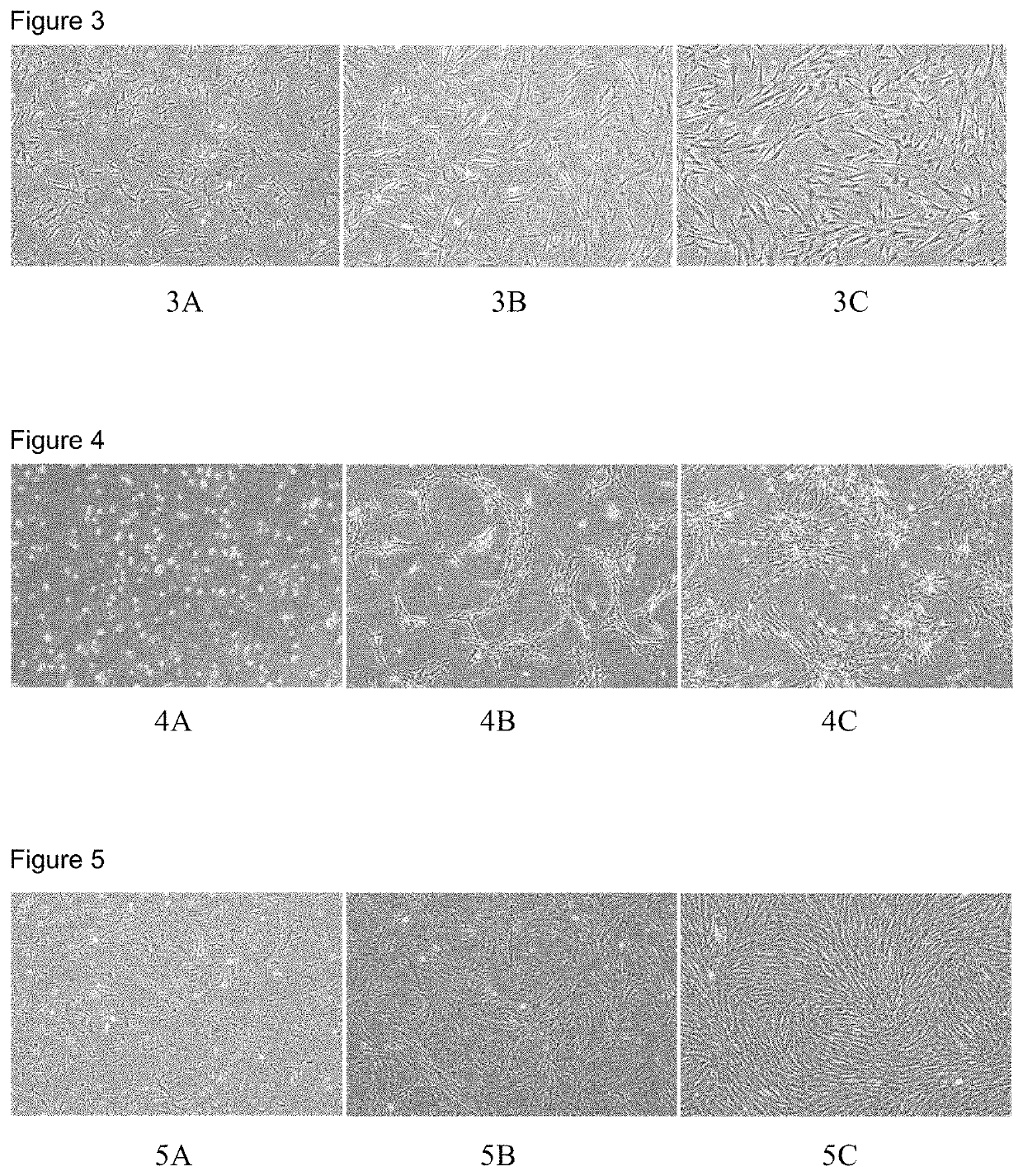Reagent kit for step-by-step hUC-MSC culture and hUC-MSC acquired using said reagent kit
a technology of reagent kit and hucmsc, which is applied in the field of stem cell research, can solve the problems of huc-mscs prone to differentiation, not only being ideal substitutes, and achieving the effects of avoiding the instability of cell growth, slow cell proliferation, and poor adhesion
- Summary
- Abstract
- Description
- Claims
- Application Information
AI Technical Summary
Benefits of technology
Problems solved by technology
Method used
Image
Examples
example 1
hUC-MSCs with Conventional Medium Containing Serum
[0044]Medium to be tested: 89 parts by volume of a-MEM, 10% fetal calf serum (FBS), 100 U / ml of penicillin, 100 U / ml streptomycin, 0.1 part by volume of β-mercaptoethanol, 10 ng / ml b-FGF, and 1 part by volume of aqueous solution of non-essential amino acids (11140, Gibco).
[0045]In a biosafety cabinet, the third generation hUC-MSCs isolated from Wharton's jelly tissue of umbilical cord of a newborn by natural delivery were inoculated into a T75 cell culture flask at a density of 2×104 cells / cm2, then the flask was transferred to a constant temperature incubator at 37° C., 5% CO2 after 15 ml of the medium to be tested was added in. Cell adhesion observed 2 hours after inoculation showed that a large amount of hUC-MSCs adhered to the walls of the flask and had tentacles stretched out; and more than 90% confluence was reached when observed 48 hours after inoculation; and the hUC-MSCs were bright and had tentacles in stretched state.
[0046...
example 2
hUC-MSCs with Conventional and Commercially Available Serum-Free Medium
[0047]With reference to the method as described in Example 1, cells from the same cell source were inoculated at the same density, and cultured with addition of 15 ml of commercially available serum-free medium (Cyagen, HUXUC-90061). The cells were observed to have adhered to the walls of the flask 2 hours after inoculation, which were bright and round, and had tentacles in stretched state; and 24 hours after inoculation, bright hUC-MSCs which had stretched tentacles and unobvious expansion could be observed under a microscope. A confluence of about 50% could be reached by the cells 48 hours afterf inoculation; and observation 72 hours after inoculation showed that the hUC-MSCs were bright and more than 90% confluence was reached. The cells were digested by trypsin, collected and cryopreserved.
[0048]Optionally, the cells were continuously cultured after a confluence of 100% was reached; however, the cells began t...
example 3
for the Composition of the Medium
(i) Screening for the Composition of the TME Medium
[0049]Medium to be tested: 0.01, 0.02, 0.05, 0.1, 0.15, 0.2, 0.3 or 0.5 part by volume of β-mercaptoethanol, 1 part by volume of aqueous solution of non-essential amino acids (11140, Gibco), and 99 parts by volume of a-MEM.
[0050]With reference to the method as described in Example 1, cells from the same cell source were inoculated at the same density, then 12-15 ml of the medium to be tested was added in and theadherence of the cells was observed.
[0051]Results: The cells in the two concentration groups, i.e. the medium comprising 0.01 or 0.02 part by volume of β-mercaptoethanol respectively adhered to the walls at a slower rate. Some of the cells still did not adhere to the walls 4 hours after inoculation and nearly all the cells were observed to have adhered about 8 hours after inoculation. The cells in the four concentration groups, i.e. the medium comprising 0.05, 0.1, 0.15 or 0.2 parts by volume ...
PUM
| Property | Measurement | Unit |
|---|---|---|
| concentration | aaaaa | aaaaa |
| concentration | aaaaa | aaaaa |
| diameter distribution | aaaaa | aaaaa |
Abstract
Description
Claims
Application Information
 Login to View More
Login to View More - R&D
- Intellectual Property
- Life Sciences
- Materials
- Tech Scout
- Unparalleled Data Quality
- Higher Quality Content
- 60% Fewer Hallucinations
Browse by: Latest US Patents, China's latest patents, Technical Efficacy Thesaurus, Application Domain, Technology Topic, Popular Technical Reports.
© 2025 PatSnap. All rights reserved.Legal|Privacy policy|Modern Slavery Act Transparency Statement|Sitemap|About US| Contact US: help@patsnap.com



